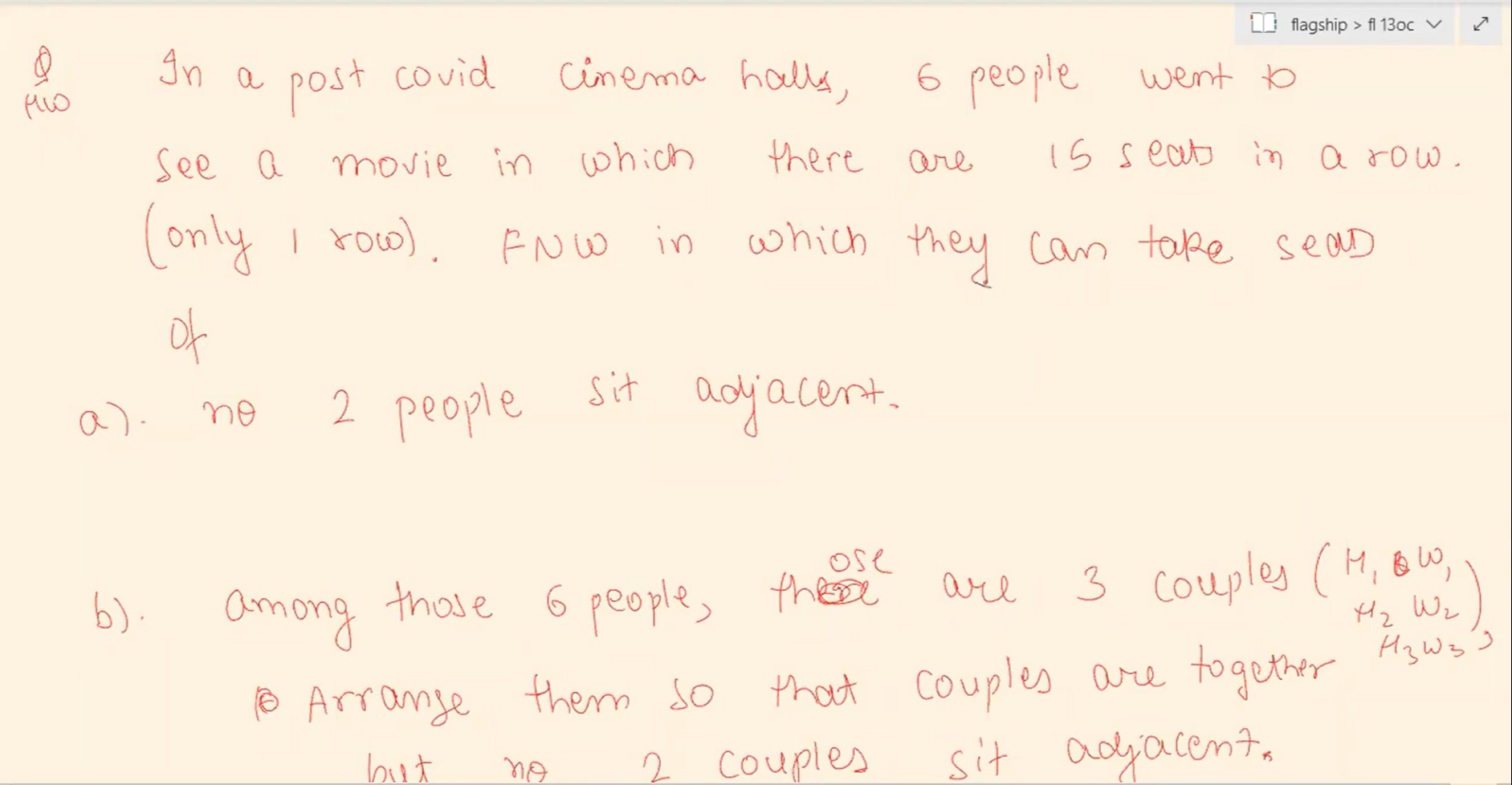Question
Question: $\frac{Q}{H\omega}$ In a post covid cinema halls, 6 people went to see a movie in which there are 15...
HωQ In a post covid cinema halls, 6 people went to see a movie in which there are 15 seats in a row. (only 1 row). FNW in which they can take seat of
a). no 2 people sit adjacent.
b). Among those 6 people, there are 3 couples (H1W1,H2W2,H3W3). Arrange them so that couples are together but no 2 couples sit adjacent.

a). 151200, b). 5760
Solution
The problem involves seating arrangements with specific restrictions, which can be solved using principles of permutations and combinations, particularly the gap method for non-adjacent arrangements.
Let N be the total number of seats = 15.
Let K be the number of people to be seated = 6.
Part a). No 2 people sit adjacent.
To ensure no two people sit adjacent, we can use the gap method.
Imagine we first place the empty seats. The remaining seats, once occupied, must be separated by at least one empty seat.
Alternatively, we can directly apply the formula for selecting non-adjacent items.
The number of ways to choose K non-adjacent items from N items arranged in a row is (KN−K+1).
In this case, we are choosing 6 seats out of 15 such that no two chosen seats are adjacent.
Number of ways to choose the seats = (615−6+1)=(610).
(610)=(10−610)=(410)=4×3×2×110×9×8×7=10×3×7=210.
Once the 6 non-adjacent seats are chosen, the 6 distinct people can be arranged in these 6 seats in 6! ways.
6!=720.
Total number of ways = (ways to choose seats) × (ways to arrange people)
Total ways = (610)×6!=210×720=151200.
Part b). Among those 6 people, there are 3 couples (H1W1,H2W2,H3W3). Arrange them so that couples are together but no 2 couples sit adjacent.
This part has two conditions:
-
Couples are together: Each couple (HiWi) must sit together. This means we treat each couple as a single unit or block. There are 3 such units: C1=(H1W1), C2=(H2W2), C3=(H3W3). Each unit occupies 2 seats.
Within each couple unit, the husband and wife can swap positions. So, for each couple, there are 2! ways. For 3 couples, this is (2!)3=23=8 ways. -
No 2 couples sit adjacent: This means the 3 couple units (C1,C2,C3) cannot be adjacent to each other.
The 3 couple units occupy a total of 3×2=6 seats.
The remaining empty seats are 15−6=9 seats.
Now, we need to arrange the 3 distinct couple units and 9 identical empty seats such that no two couple units are adjacent.
We use the gap method:
First, arrange the 9 empty seats. This creates 9+1=10 possible gaps where the couple units can be placed.
_ E _ E _ E _ E _ E _ E _ E _ E _ E _
To ensure no two couple units are adjacent, each couple unit must be placed in a different gap.
Number of ways to choose 3 gaps out of 10 available gaps = (310).
(310)=3×2×110×9×8=10×3×4=120.
Once the 3 gaps are chosen, the 3 distinct couple units (C1,C2,C3) can be arranged in these 3 chosen gaps in 3! ways.
3!=6.
Total number of ways = (ways to choose gaps for couple units) × (ways to arrange couple units) × (ways to arrange members within couples)
Total ways = (310)×3!×(2!)3=120×6×8=5760.
